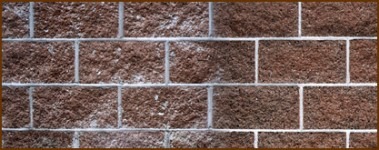May 2008
Cleaning
Consider your masonry crew has worked on a project for months, taking great pride in the final result. Before you can turn it over to the owner, a vital part of the process must be completed: cleaning.
By K.K. Snyder
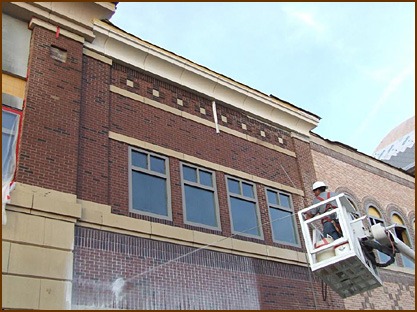
No matter how much quality goes into a masonry job, it must be clean when the owner inspects it, or all that hard work won’t matter a bit. The key to efficient, professional cleaning of masonry is the equipment used for the job. Knowing what equipment to use and how to use it can assure you top results.
“When building a masonry building, it’s kind of a messy job,” says Gary Henry, business communications specialist for PROSOCO, which sells the chemicals used to clean masonry and offers recommendations as to how those cleaners need to be applied for the best results.
“In the construction process, you’re going to get some dirt and mud on the building, as well as mortar smears and excess mortar where you’re laying the masonry,” he says. “All that stuff has to be cleaned off before the building is ready for the client, and it’s going to take more than dishwashing detergent to get dried mortar off masonry.”
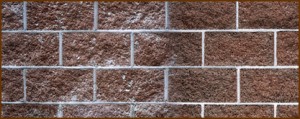
Regardless of which machine and chemicals you choose to use, you’re going to need water, and lots of it. From pre-wetting to rinsing, clean water is essential, whether for new construction, building maintenance or restoration cleaning. Along with water, specialized cleaners take contaminants off masonry, leaving the brick “as pristine and beautiful as when the client came in to select the brick in the showroom,” says Henry.
Applying potent chemicals has to be done with a high amount of care and attention during new construction clean down, beginning with applying a great deal of water to the brick, typically with a pressure washer. By pre-soaking the masonry, the microscopic pores of the bricks become filled with water, which will later keep the chemicals on the surface of the bricks, guarding against penetration.
If the chemicals penetrate the brick and aren’t flushed out fully, it can be harmful to the appearance later when the building dries, as a white residue will be left behind on the masonry, according to Henry. For the pre-wetting process, he recommends using equipment that can put six to eight gallons per minute on the brick at 50 to150 psi.
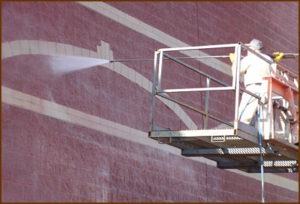
“The secret to pre-wetting is lots of gallons per minute, but at a low pressure,” says Henry. “People who are inexperienced with cleaning buildings tend to think the higher the pressure, the better. But it’s not the high pressure that blasts stuff off the building; it’s the chemicals that dissolve the contaminants. High pressure can actually damage a building.”
In fact, using anything higher than 1,000 psi can cause blowout of mortar joints and leave wand marks on the building, causing damage that a contractor will have to repair.
Chemicals to the rescue
Once the bricks are thoroughly saturated with water, it’s time to apply the chemicals with some type of sprayer at a maximum rate of 50 psi. Anything higher will drive the chemicals into the masonry pores, even if they were properly filled with water during the pre-wetting step. For this task, a pump sprayer is one of the best alternatives, says Henry, but chemicals also can be applied the old-fashioned way, with a bucket and a brush.
“You have to make sure the equipment is acid resistant, because cleaners always have a small component of highly purified, often high-food-grade acids in them, which can damage equipment over time,” says Henry. “While the acids dissolve excess mortar, the oil, grease, dirt and mud take detergents and soaps [for removal].”
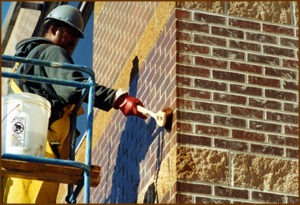
In addition, wetting agents in chemicals help magnify the effectiveness of a small amount of acid, while controlling the power of that acid, he continues. But with all that control, you still need to use acid-resistant equipment, even if you’re using a bucket-and-brush method to clean.
“Acid and metal are always a bad mixture, so when mixing cleaners, use plastic buckets instead of metal,” Henry adds, noting that chemicals made for routine cleaning aren’t as harsh and don’t usually have the acid element that could cause damage to a building during years of routine maintenance.
Likewise, when you’re performing restoration cleaning on a building aged 100 years or more (especially one located in the urban Northeast, where air pollution deposits carbon and gypsum rust on the brick as deep as one-eighth of an inch or more), it’s tougher to get the masonry clean, so stronger chemicals may be needed. Henry says the difference will be in the delicate nature of older brickwork.
“With restoration cleaning, it’s even more important to pay attention to the psi,” he says. “Masonry 100 years old is going to be a bit more delicate than new construction and, if the psi is too high, you can blow old, weather-weakened masonry to bits.”
The Cardinal Rule, he says, is to always do a test, so you can try out the equipment, adjust the psi and practice the chemical procedure, especially with restoration work.
“You don’t want to open with 1,000 psi and find the 100-year-old masonry crumbles under the high pressure,” he says.
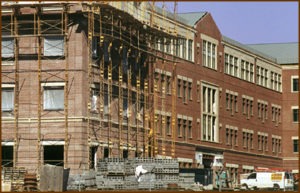
Second Opinion
Randy Weil, owner of Kem-O-Kleen, agrees with this process, but he doesn’t believe staying under 1,000 psi is necessary, especially with regard to new-construction clean down. In fact, he says his masonry cleaning machine (invented and designed by a mason) operates at 3,000 psi and is perfect for getting the job done efficiently.
Invented by Charlie Hewitt, a mason with 35 years of experience in the industry and tired of cleaning brick with a bucket of muriatic acid and a brush, the Kem-O-Kleen machine — specifically the K3003-12 preferred by masons — is a hot water pressure washer that introduces the cleaning chemicals into the stream following pre-wetting. This patented technology covers not only the overall machine, but also a number of individual features.
Weil offers this equation for masonry cleaning:
“We focus on minimum time and getting a very effective clean, Weil says, noting that the hydrochloric acid-based chemicals used by masons for cleaning are much more active in hot water than in water at an ambient temperature. He estimates that masons using his piece of equipment can complete a job in one-third the time it would take with a more traditional method, such as a bucket and brush. In addition, using Kem-O-Kleen takes about half the time to finish a cleaning job versus using a pressure washer and applying the chemicals with a brush or Hudson sprayer before the final rinse.
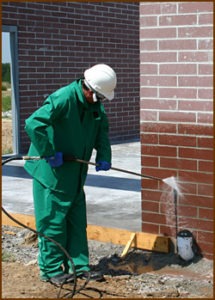
“When you wet the wall down, it immediately begins to cool before you can even get the chemical on the wall,” he says, noting that the hot water pressure washer not only saturates the brick, it also heats it, preparing it for the chemicals about to be added into the stream without any delay in between steps.
From a process consistency perspective, Kem-O-Kleen’s needle valve precisely measures chemicals into the water stream at a ratio of about 10-to-one. Traditional methods often apply chemicals onto the masonry more heavily in some spots than others, and can cause excess chemicals to run down the bricks.
So what about potential damage to masonry with such a high psi? “That’s at the nozzle,” explains Weil. “We recommend 16 to 18 inches between the nozzle and the wall, so there isn’t 3,000 psi hitting the wall, and it doesn’t blow out joints. If you have a more sensitive brick, you can adjust the pressure or just stand back farther.”
Maintenance of the equipment is easy, says Weil, adding that chemicals can be left in the 20-gallon on-board tank between jobs, but not when stored away for the winter, for example. “It cleans up after itself,” he adds.
If such equipment is to be stored for a number of months, however, he recommends flushing the equipment with windshield-washing fluid or antifreeze. In addition, the use of this machine and similar equipment doesn’t allow for the reuse of chemicals, so a quality result can be expected every time.
To use Kem-O-Kleen for maintenance cleaning or restoration work requires a separate nozzle assembly for the wand, which enables the user to apply the chemicals and allow them to dwell for a short time before rinsing.
Robert Port, VP of engineering for Restoration Direct, says the secret to cleaning buildings is not so much washing it off, but using equipment designed to apply chemicals without overspray or penetration.
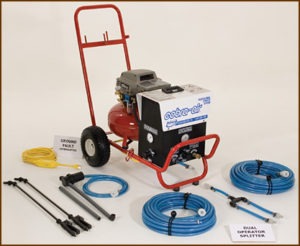
“If I put chemicals on the wall to clean, like it or not, the dirt is on the surface, not one-quarter of an inch in,” Port says, noting that overspray, penetration and “bounce back” are wastes of the chemicals. (Bounce back refers to bouncing the chemical off the wall and letting it fall to the ground.) “Our equipment is designed specifically to avoid those three things. Also, the chemicals you apply will eat the guts out of an airless sprayer.”
Restoration Direct makes the Cobra Air Sprayer System, which allows masons to cut their time in half, says Port, noting that the sprayer can empty a 55-gallon drum of chemicals onto a building in 30 minutes, whereas other equipment can take four hours to distribute the same amount. In fact, the company entered the Cobra in a national competition in 2003 and took first place for speed and efficiency.
Whether you choose to clean masonry with a traditional pressure washer, a hot water pressure washer that adds chemicals to the water stream, an air sprayer system or the old-fashioned bucket-and-brush method, your time and money are at stake, as is the most valuable thing you have in this business: your reputation for quality, clean masonry work.
K.K. Snyder is an Albany, Ga.-based freelancer writer and editor. She can be reached at kkondeadline@hotmail.com.
